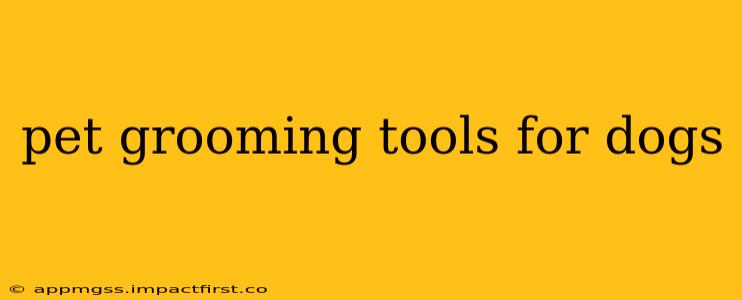Keeping your canine companion looking and feeling their best involves regular grooming. While professional grooming is beneficial, having the right tools at home allows for consistent maintenance and strengthens the bond between you and your furry friend. This comprehensive guide covers the essential pet grooming tools for dogs, addressing common questions pet owners have.
What are the basic grooming tools I need for my dog?
The basic tools you'll need depend on your dog's breed, coat type, and your grooming goals. However, a good starting point includes:
- A high-quality brush: The type of brush depends on your dog's coat. Dogs with short, smooth coats need a slicker brush or rubber curry brush to remove loose hair and stimulate their skin. Dogs with longer, thicker coats benefit from a bristle brush, undercoat rake, or de-shedding tool to remove mats and tangles.
- A wide-toothed comb: This is essential for detangling longer coats and removing mats, especially in sensitive areas.
- Dog-specific shampoo and conditioner: Using human shampoo can dry out your dog's skin, so always opt for a formulation designed for canine skin and coat.
- Soft towels: You'll need several absorbent towels to dry your dog thoroughly after bathing.
- Nail clippers: Regular nail trims are crucial for your dog's comfort and health. Choose clippers specifically designed for dogs, either guillotine-style or scissor-style.
- Dog toothpaste and toothbrush: Dental hygiene is vital. Use dog-specific toothpaste as human toothpaste is toxic to dogs.
What kind of brush should I use for my dog's coat?
Choosing the right brush is crucial. Here's a breakdown:
- Slicker brush: Ideal for short-haired breeds, removing loose hair and dirt effectively.
- Bristle brush: Suitable for medium to long-haired breeds, helping to distribute natural oils and prevent matting.
- Undercoat rake: Excellent for removing excess undercoat, particularly beneficial for breeds that shed heavily.
- De-shedding tool: Specifically designed to remove loose undercoat and minimize shedding.
- Dematting tool: Used to carefully remove mats and tangles from long or thick coats. Use caution as improper use can cause discomfort.
What are the best nail clippers for dogs?
Dog nail clippers come in two main types:
- Guillotine clippers: These have a small guillotine-like blade that cuts the nail. They are precise but require a bit of practice to use correctly.
- Scissor clippers: These resemble small scissors and are generally easier to use for beginners.
Regardless of the type you choose, always ensure the blades are sharp to prevent crushing or splitting the nail. If you are uncomfortable trimming your dog's nails yourself, consult a professional groomer.
How often should I groom my dog?
Grooming frequency depends on your dog's breed and coat type. Short-haired breeds may only need brushing once or twice a week, while long-haired breeds may require daily brushing to prevent matting. Bathing frequency also varies, but generally, every 4-8 weeks is sufficient unless your dog gets particularly dirty. Nail trims should be done every 2-4 weeks, or as needed.
What other grooming tools might I need?
Depending on your dog's needs and your grooming preferences, you might also consider these additional tools:
- Dog hair dryer: A low-noise, adjustable-temperature dryer can be helpful for speeding up the drying process after bathing.
- Ear cleaning solution and cotton balls: Regular ear cleaning helps prevent infections. Always use a dog-specific ear cleaning solution.
- Dog grooming wipes: Convenient for quick clean-ups between baths.
By investing in the right pet grooming tools for dogs and establishing a regular grooming routine, you can ensure your furry friend stays healthy, happy, and looking their best. Remember, always prioritize your dog's comfort and safety during grooming. If you are ever unsure about any aspect of dog grooming, consult with a professional groomer for advice.
